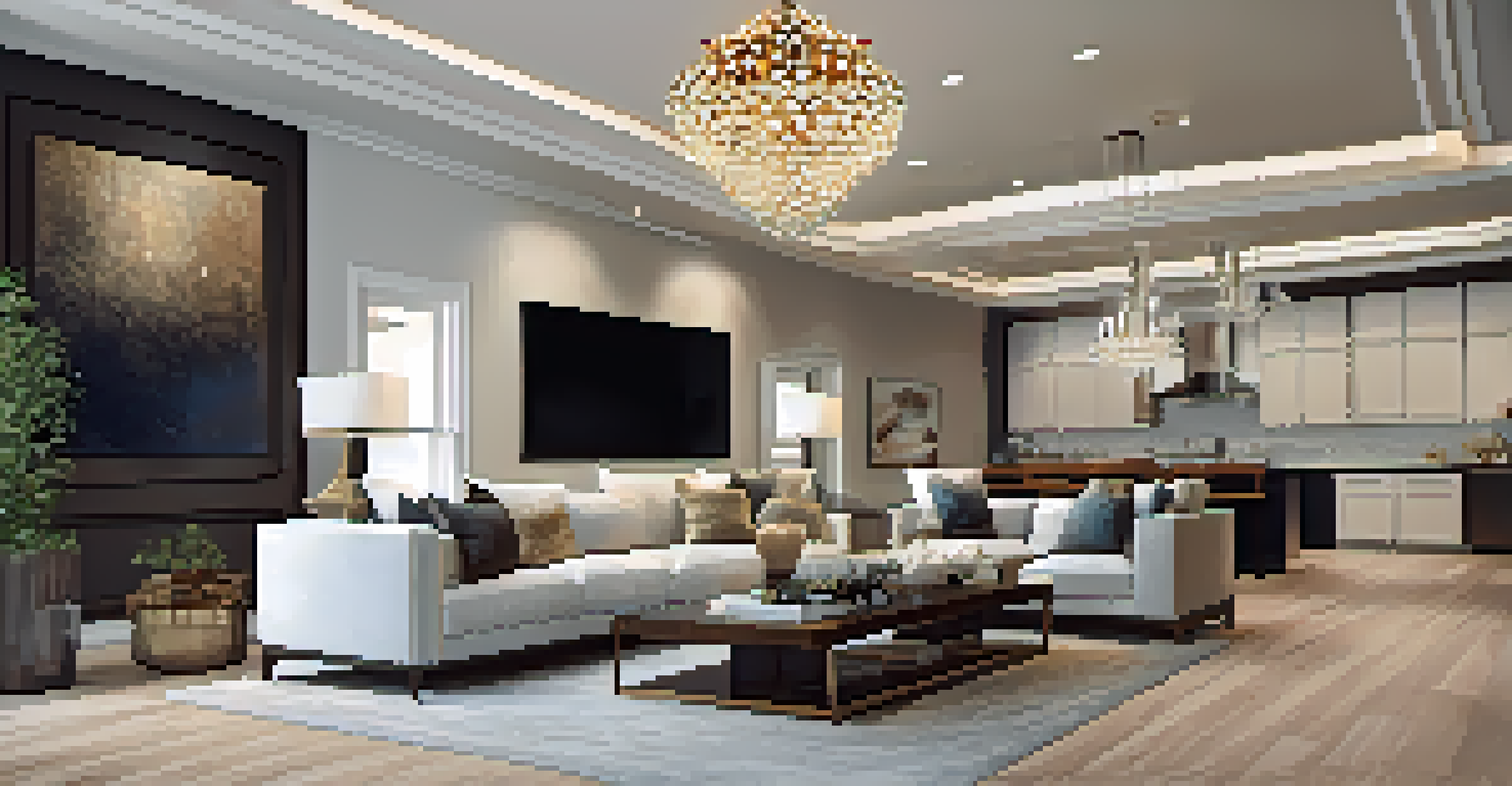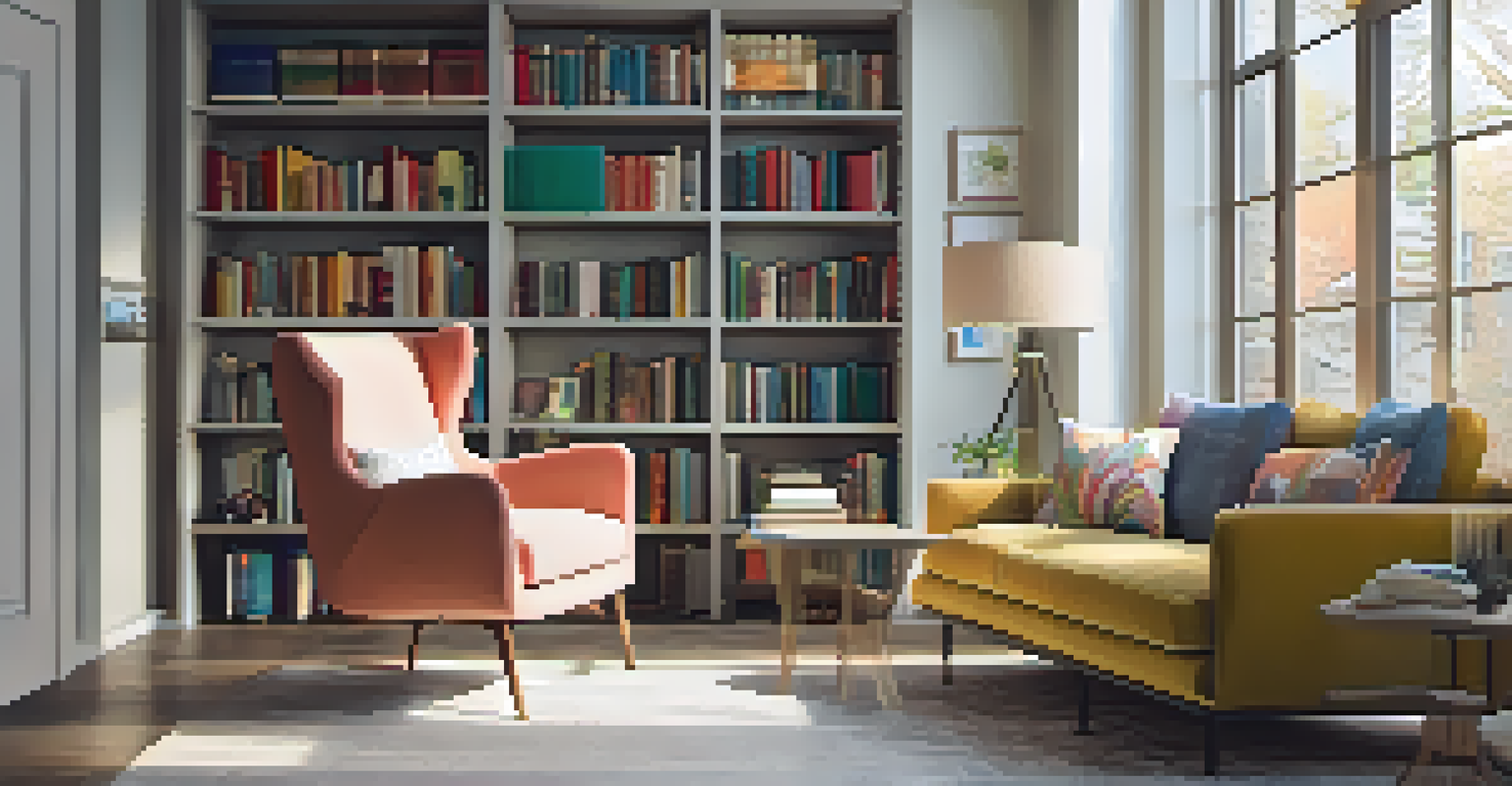Choosing the Right Lighting for Open Concept Living Areas

Understanding the Importance of Lighting in Open Spaces
Lighting plays a crucial role in open concept living areas, as it can dramatically influence the mood and functionality of the space. Unlike closed-off rooms, these areas require a thoughtful approach to lighting that enhances both aesthetics and practicality. Good lighting can define different zones within the open space, creating a cohesive yet varied environment that invites comfort and interaction.
Lighting is the artwork that brings your space to life.
In an open concept layout, you often have multiple activities happening simultaneously, from cooking to entertaining. The right lighting can help delineate these areas without the need for physical barriers. Think of it as painting with light; each fixture can highlight a different part of the room, making it feel more dynamic and inviting.
Moreover, effective lighting can also address the challenges of natural light variations throughout the day. By choosing the right fixtures, you can ensure your space remains bright and welcoming, regardless of the time of day or the weather outside.
Selecting the Right Types of Lighting Fixtures
When it comes to lighting fixtures, variety is key in open concept areas. You’ll want to combine ambient, task, and accent lighting to create a balanced atmosphere. Ambient lighting provides the general illumination needed for the entire space, while task lighting focuses on specific areas where activities take place, like reading or cooking.

Consider options like pendant lights over kitchen islands, floor lamps in reading nooks, or wall sconces that highlight artwork. By layering these types of lighting, you not only enhance functionality but also add depth and interest to your design. It’s like creating a playlist; each type of light plays its own part in the overall composition.
A common mistake is to rely solely on one type of lighting fixture, which can lead to a flat and uninviting space. By mixing and matching, you can achieve a more vibrant and adaptable environment that caters to various moods and occasions.
Utilizing Natural Light to Your Advantage
Natural light is a fantastic asset in any open concept living area, so it’s essential to maximize its presence. Large windows and open layouts often allow for abundant sunlight, which can create a warm and inviting atmosphere. Use sheer curtains or blinds that can easily be opened to let the light in while maintaining your privacy.
Good lighting can transform a space and elevate the mood, making it feel more inviting and functional.
To enhance the effect of natural light, consider reflective surfaces like mirrors or glossy finishes on furniture. These elements can bounce light around the room, making the space feel larger and more airy. Think of it as amplifying a beautiful melody; reflective surfaces can take the sunlight and make it sing throughout your living area.
However, it's also important to balance natural light with artificial sources, especially during the evening. Incorporating dimmable fixtures can help transition from bright daytime light to a cozy nighttime glow, ensuring your space remains versatile and inviting.
Creating a Focal Point with Statement Lighting
In open concept living areas, statement lighting can serve as a stunning focal point, drawing the eye and adding character to the space. A unique chandelier or an oversized pendant light can become a conversation starter and a defining feature of your design. It’s like wearing a bold accessory that ties your entire outfit together.
Choosing a statement fixture can also help to anchor the space visually, providing a sense of structure to the open layout. Make sure the scale of the fixture suits the height and dimensions of your area; a large space can handle a grand fixture, while smaller spaces may benefit from more minimalist designs.
In addition to aesthetics, consider the function of the statement lighting. It should not only look good but also provide adequate light for the area it occupies, ensuring that it enhances both the beauty and usability of your open concept living space.
Incorporating Smart Lighting Solutions
Smart lighting technology has revolutionized how we illuminate our homes, offering convenience and versatility, especially in open concept spaces. With smart bulbs and systems, you can control the brightness and color temperature of your lighting from your smartphone or through voice commands. This means you can easily adjust the ambiance to suit different activities or moods.
Imagine hosting a dinner party; you can set the lighting to a warm, inviting hue with just a few taps on your phone. Conversely, if you’re winding down for the evening, you can dim the lights to create a relaxing atmosphere. This level of control allows for a personalized experience that adapts to your lifestyle.
Furthermore, smart lighting can help with energy efficiency, allowing you to schedule lights to turn off when not in use or adjust automatically based on the time of day. Embracing this technology not only enhances convenience but also aligns with a modern, eco-friendly approach to home design.
Choosing the Right Color Temperature for Your Space
Color temperature is a crucial factor in creating the right atmosphere in your open concept living area. Measured in Kelvins, this aspect of lighting affects how warm or cool the light appears. Warmer tones (around 2700K-3000K) create a cozy, inviting environment, perfect for living and dining areas, while cooler tones (4000K and above) are more suitable for workspaces or kitchens.
Selecting the appropriate color temperature can greatly influence the mood of your space. For example, softer, warmer light can make a room feel more intimate and relaxing, ideal for family gatherings or quiet evenings. On the other hand, cooler light can invigorate a space, making it feel more energetic and vibrant, suitable for entertaining.
To achieve a harmonious look, consider mixing different color temperatures in your lighting scheme. For instance, you might pair warm ambient lighting with cooler task lighting in the kitchen, creating a balanced yet dynamic atmosphere that caters to various needs.
Maintaining Flexibility in Your Lighting Design
One of the key advantages of open concept living areas is their flexibility, and your lighting design should reflect that. As your lifestyle changes or as you update your décor, having adjustable lighting options can ensure your space remains functional and stylish. This could mean using fixtures that can be easily moved or replaced based on your current needs.
Consider incorporating features like track lighting or adjustable sconces that can be repositioned as desired. This approach allows you to adapt your lighting to different seasons, occasions, or even furniture arrangements. It’s akin to rearranging a room; just a few tweaks can create a whole new atmosphere.

Additionally, keep in mind the importance of dimmers and multi-functional fixtures. These elements allow you to adjust the intensity of the light to suit various activities, from brightening up for a lively gathering to dimming down for a cozy movie night. Flexibility in your lighting design ensures your open concept living area remains a welcoming and versatile space.